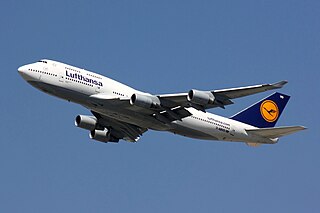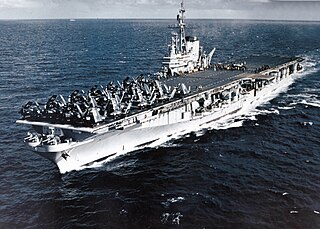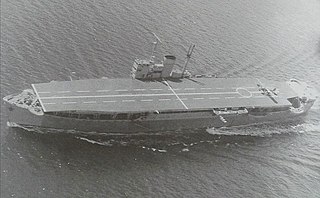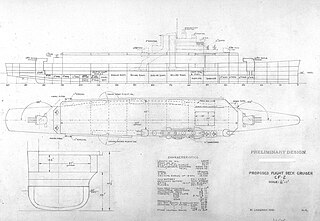A flight deck is the platform of an aircraft carrier used for takeoffs and landings.
Flight deck may also refer to:
- The cockpit of a typically larger aircraft such as an airliner, transport aircraft, bomber aircraft etc.
A flight deck is the platform of an aircraft carrier used for takeoffs and landings.
Flight deck may also refer to:

An aircraft carrier is a warship that serves as a seagoing airbase, equipped with a full-length flight deck and facilities for carrying, arming, deploying, and recovering aircraft. Typically, it is the capital ship of a fleet, as it allows a naval force to project air power worldwide without depending on local bases for staging aircraft operations. Carriers have evolved since their inception in the early twentieth century from wooden vessels used to deploy balloons to nuclear-powered warships that carry numerous fighters, strike aircraft, helicopters, and other types of aircraft. While heavier aircraft such as fixed-wing gunships and bombers have been launched from aircraft carriers, these aircraft have not landed on a carrier. By its diplomatic and tactical power, its mobility, its autonomy and the variety of its means, the aircraft carrier is often the centerpiece of modern combat fleets. Tactically or even strategically, it replaced the battleship in the role of flagship of a fleet. One of its great advantages is that, by sailing in international waters, it does not interfere with any territorial sovereignty and thus obviates the need for overflight authorizations from third-party countries, reduces the times and transit distances of aircraft and therefore significantly increases the time of availability on the combat zone.

USS Ranger (CV-4) was an interwar United States Navy aircraft carrier, the only ship of its class. As a Treaty ship, Ranger was the first U.S. vessel to be designed and built from the keel up as a carrier. She was relatively small, just 730 ft (222.5 m) long and under 15,000 long tons (15,000 t), closer in size and displacement to the first US carrier—Langley—than later ships. An island superstructure was not included in the original design, but was added after completion.

The Boeing 747-400 is a large, long-range wide-body airliner produced by Boeing Commercial Airplanes, an advanced variant of the initial Boeing 747. The "Advanced Series 300" was announced at the September 1984 Farnborough Airshow, targeting a 10% cost reduction with more efficient engines and 1,000 nautical miles [nmi] of additional range. Northwest Airlines became the first customer with an order for 10 aircraft on October 22, 1985. The first 747-400 was rolled out on January 26, 1988, and made its maiden flight on April 29, 1988. Type certification was received on January 9, 1989, and it entered service with NWA on February 9, 1989.
Deck may refer to:

The Boeing E-4 Advanced Airborne Command Post (AACP), the current "Nightwatch" aircraft, is a strategic command and control military aircraft operated by the United States Air Force (USAF). The E-4 series are specially modified from the Boeing 747-200B for the National Emergency Airborne Command Post (NEACP) program. The E-4 serves as a survivable mobile command post for the National Command Authority, namely the President of the United States, the Secretary of Defense, and successors. The four E-4Bs are operated by the 1st Airborne Command and Control Squadron of the 595th Command and Control Group located at Offutt Air Force Base, near Omaha, Nebraska. An E-4B when in action is denoted a "National Airborne Operations Center" and has been nicknamed the "Doomsday plane".

The flight deck of an aircraft carrier is the surface from which its aircraft take off and land, essentially a miniature airfield at sea. On smaller naval ships which do not have aviation as a primary mission, the landing area for helicopters and other VTOL aircraft is also referred to as the flight deck. The official U.S. Navy term for these vessels is "air-capable ships".

The Midway-class was a class of three United States Navy aircraft carriers. The lead ship, USS Midway, was commissioned in September 1945 and decommissioned in 1992. USS Franklin D. Roosevelt was commissioned in October 1945, and taken out of service in 1977. USS Coral Sea was commissioned in April 1947, and decommissioned in 1990.

The Forrestal-class aircraft carriers were four aircraft carriers designed and built for the United States Navy in the 1950s. The class ship was named for James Forrestal, the first United States Secretary of Defense. It was the first class of supercarriers, combining high tonnage, deck-edge elevators and an angled deck. The first ship was commissioned in 1955, the last decommissioned in 1998. The four ships of the class were scrapped in Brownsville, Texas, between 2014 and 2017.
Pack or packs may refer to:

Naval aviation is the application of military air power by navies, whether from warships that embark aircraft, or land bases.
Tweet often refers to:
Top Gun is a 1986 feature film starring Tom Cruise.

USS America (LHA-6), is an amphibious assault ship of the United States Navy and the lead ship of the America-class amphibious assault ship. The fourth U.S. warship to be named for the United States of America, she was delivered in spring of 2014, replacing Peleliu of the Tarawa class. Her mission is to act as the flagship of an expeditionary strike group or amphibious ready group, carrying part of a Marine expeditionary unit into battle and putting them ashore with helicopters and V-22 Osprey tilt-rotor aircraft, supported by F-35B Lightning II aircraft and helicopter gunships.
A ouija is a flat board purportedly used to communicate with the spirits of the deceased.

An amphibious assault ship is a type of amphibious warfare ship employed to land and support ground forces on enemy territory during an amphibious assault. The design evolved from aircraft carriers converted for use as helicopter carriers. Modern designs support amphibious landing craft, with most designs including a well deck. Like the aircraft carriers they were developed from, some amphibious assault ships also support V/STOL fixed-wing aircraft and have a secondary role as aircraft carriers.

Modern United States Navy aircraft carrier air operations include the operation of fixed-wing and rotary aircraft on and around an aircraft carrier for performance of combat or noncombat missions. The flight operations are highly evolved, based on experiences dating back to 1922 with USS Langley.

Akitsu Maru (あきつ丸) was a Japanese landing craft depot ship and escort aircraft carrier operated by the Imperial Japanese Army (IJA). In some sources Akitsu Maru and her sister ship Nigitsu Maru (にぎつ丸) are also considered to be the first amphibious assault ships.

The flight-deck cruiser was a proposed type of aircraft cruiser,, designed by the United States Navy during the Interwar period. Several designs were proposed for the type, but none was approved for construction. The final design was developed just before World War II, and the entry of the United States into the war saw the project come to an end.

The Essex class was a class of aircraft carriers of the United States Navy. The 20th century's most numerous class of capital ship, the class consisted of 24 vessels, which came in "short-hull" and "long-hull" versions. Thirty-two ships were ordered, but as World War II wound down, six were canceled before construction, and two were canceled after construction had begun. Fourteen saw combat during World War II. None were lost to enemy action, though several sustained crippling damage. Essex-class carriers were the backbone of the U.S. Navy from mid-1943 and, with the three Midway-class carriers added just after the war, continued to be the heart of U.S. naval strength until supercarriers joined the fleet in the 1950s, 1960s and 1970s. Several of the carriers were rebuilt to handle heavier and faster aircraft of the early jet age, and some served until well after the Vietnam War.

In aviation, a ski-jump is an upward-curved ramp that allows aircraft to take off from a runway that is shorter than the aircraft's required takeoff roll. By forcing the aircraft upwards, lift-off can be achieved at a lower airspeed than that required for sustained flight, while allowing the aircraft to accelerate to such speed in the air rather than on the runway. Ski-jumps are commonly used to launch airplanes from aircraft carriers that lack catapults.